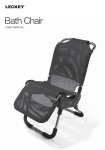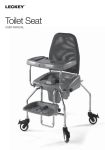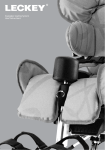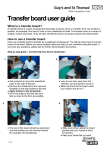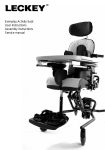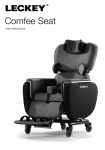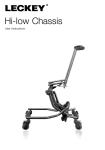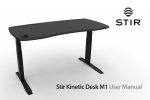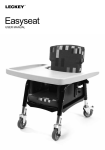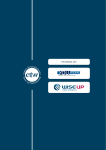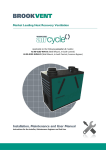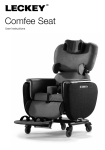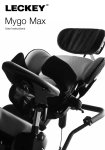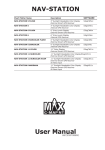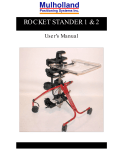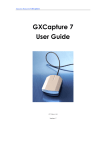Download Squiggles user Saddle A5
Transcript
Squiggles Saddle Seat User Instructions The Squiggles Saddle Seat has been designed to offer a comfortable and functional seating posture from where children can enjoy a broad range of activities. This manual shows how you can quickly, safely and easily make use of all the functions. The instructions on the safety and maintenance will ensure that you will enjoy the use of this product for a long time. Contents 01 02 03 04 05 06 07 08 09 10 11 12 13 14 15 16 Intended use Declaration of conformity Terms of warranty Product history record Product training record Safety information How to unpack and assemble the seating system Fitting the cushions Clinical setup for postural management Frequent adjustments for daily use Cleaning & care information Daily product inspection Annual product inspection Reissuing Leckey products Product servicing Technical information 4 Safety Information 1. Intended Use The Squiggles Saddle Seat is an activity chair which has been designed for children with special needs aged 2-5 who would benefit from additional support when sitting to enable them to focus their attention on various activities. This seating system has a maximum user weight of 22kg (48.4lbs).The seat can be used at home or in the classroom. 2. Declaration of Conformity James Leckey Design Ltd as manufacturer with sole responsibility declares that the Squiggles Saddle Seat conforms to the requirements of the 93/42/EEC Guidelines and EN12182 Technical aids for disabled persons general requirements and test methods. 3. Terms of Warranty The warranty applies only when the product is used according to the specified conditions and for the intended purposes, following all manufacturer’s recommendations (also see general terms of sales, delivery and payment). A two year warranty is provided on all Leckey manufactured products and components. 4. Product History Record Your Leckey product is classified as a Class 1 Medical device and as such should only be prescribed, set up or reissued for use by a technically competent person who has been trained in the use of this product. Leckey recommend that a written record is maintained to provide details of all setups, reissue inspections and annual inspections of this product. 5. Product Training Record (Parents, Teachers & Carers) Your Leckey product is a prescribed Class 1 Medical Device and as such Leckey recommend that parents, teachers and carers using the equipment should be made aware of the following sections of this user manual by a technically competent person: Section 6 Safety Information Section 10 Frequent Adjustments for Daily use Section 11 Cleaning and Maintenance Section 12 Daily Product Inspection Leckey recommend that a written record is maintained of all those who have trained in the correct use of this product. 1. Always read instructions fully before use. 2 Users should not be left unattended at any time whilst using Leckey equipment. 3. Only use Leckey approved components with your product. Never modify the product in any way. Failure to follow instructions may put the user or carer at risk and will invalidate the warranty on the product. 4. If in any doubt to the continued safe use of your Leckey product or if any parts should fail, please cease using the product and contact our customer services department or your local dealer as soon as possible. 5. Carry out all positional adjustments and ensure that they are securely fastened before you put the user into the product. Some adjustments may require the use of a tool which is provided with each product. Keep all tools out of reach of children. 6. When putting the user into a seating system, both for positional and safety reasons, always secure the pelvic harness first. 7. When the product is stationary ensure that all castors are locked and facing away from the base as this will improve product stability. This is especially important when the tilt in space or back recline facility is in use. 8. When the seat is in use on a Hi low chassis please ensure that the height adjustment pedal and tilt in space lever are locked off and cannot be adjusted accidentally by other children. When used on an Easy chassis please ensure that the height adjustment ratchet handle and the tilt in space lever are locked off and cannot be adjusted accidentally by other children. 9. When the Leckey Seating systems are used on the Hi low or Easy chassis we do not recommend that users are moved over uneven surfaces when in the equipment. All due care and attention should be taken if transporting the user in and out of the seat. 10. Never leave the product on a sloping surface, greater than 5 degrees. Always remember to lock all the castors. 11. Only use the push handle to steer and move the seat from one area to another. Never use the tray for this purpose. 12. The product contains components which could present a choking hazard to small children. Always check that locking knobs and bolts within the child’s reach are tightened and secure at all times. 13. Leckey products comply with fire safety regulations in accordance with EN12182. However the product contains plastic components and therefore should be kept away from all direct sources of heat including naked flames, cigarettes, electric and gas heaters. 14. Do not place hot objects on the tray greater than 40ºC. 15. Clean the product regularly. Do not use abrasive cleaners. Carry out maintenance checks on a regular basis to ensure your product is in good working condition. 16 The product is designed for indoor use and when not in use should be stored in a dry place that is not subjected to extremes of temperature. The safe operating temperature range of the product is +5 to +40 deg Celsius. How to unpack and assemble the saddle seat 17 Always check the plastic hand knobs on the push handle are tightened securely before you move the seat unit. 18 Before using the seating system always check that the interface handle on the seat unit is fully engaged with the chassis. Make sure the locking pin in engaged so the handle cannot be accidentally released. If the handle is not engaged properly the seat unit may come loose and could cause serious injury to the child or carer. 7 Check parts Congratulations on purchasing your Squiggles Saddle Seat. When opening the boxes, cut the straps, taking care not to cut through the tape as you may damage some of the parts contained inside. All of the parts will be contained in polythene bags with each one clearly labelled. Carefully remove them from the boxes and check you have all the parts you have ordered. Safety First Keep polythene bags away from children. Multi-tool A number of adjustments outlined below will require the use of an allen key, which are supplied with each seat. Attaching the footplate If you have ordered a footplate we recommend that you attach it first. You will need the multi tool and spanner which are supplied. To attach the foot plate first set the seat base upside down on a secure surface at working height. Hold the foot plate support stem in place and push the socket bolt provided through the hole in the side. Feed it through the holes and set on the securing nut, tightening the socket cap bolt a couple of turns to hold it in place. Next, use the spanner to hold the nut and tighten the socket cap bolt using the multi tool. Do not over tighten them as this needs to be free to allow the footplate and stem to be angled. Finally fit the adjustment lever. To do this feed the cup square bolt through the slot and hole. Set on the washer and hand lever. Tighten the bolt clockwise a couple of turns to start it on the thread. Then push the bolt into the slot and tighten the hand lever. You will have to tighten half a turn at a time. To do this turn the hand lever half a turn clockwise, then lift the lever and rotate it back half a turn like this. Keep turning back and forward until it is secure. Always make sure the footplate is firmly attached. Attaching the seating system to the Hi Low or the Easy Chassis Adjust the height of the chassis to its maximum to reduce risk of back strain while attaching the seat unit. Refer to section 10 on how to adjust the height of the chassis you have purchased. Always check the handle and locking pin are fully engaged before you place the child in the seating system. If the handle is not engaged properly the seat unit can come loose and could cause serious injury to the child or carer. Attaching the back rest Attaching the push handle To attach the backrest, slide the backrest tube into upright receiving tube at the back of the product, then tighten the knob (A) securely. The push handle is attached to both the Hi Low chassis and the Easy Chassis by inserting the two lower stems into the receiving tubes as shown. The push handle has safety poppers, which need to be pressed in when inserting the lower stems. On the Hi Low chassis push the stems in until the poppers protrude from the other end of the receiving tubes. First release the safety locking pin at the front of the seat. To do this pull the pin out and rotate through 90 degrees. Carefully lift the seat and place it into the chassis. At the rear of the underside of the seat you will see a receiving channel. Place this securely over the tube towards the back of the chassis. Pull the handle at the front of the seat unit up and then pivot the seat forward and down. Once the front of the seat is lowered fully, release the handle and push it forward to ensure it has fully engaged on the front tube. Rotate the safety locking pin (A) so it engages in front of the handle. If it hits the handle then the seat is not inserted properly, remove and repeat process outlined above. On the Easy chassis the popper will engage in a hole in the receiving tube. Once inserted secure the push handle by tightening the two hand knobs (B) underneath. Check the knobs are tight before youmove the product, particularly if you are moving the seat unit along corridors that may have uneven or sloping surfaces. A B A B Attaching the sandals Attaching the lateral supports If sandals are required they can be attached to the footplates with a single fixing bolt. To position the sandals simply loosen the knob under the footplate, select the position you require and re-fasten the knob. Remove the plastic knob from the locking nut. Slide the bracket through the slot. Place the nut on the inside, insert the knob through the hole and tighten securely. Fitting the cushions 8 Seat cushion Lateral support padded cushions Backrest cushion To begin, slide the cushion over the pommel, press down on the central seat base to locate the velcro panels. Then wrap the side panels around the sides of the seat base and attach the velcro panels to the underside of the seat cushion. Feed the pelvic harness through the slits in the fabric. Wrap the side panels around the seat and secure the snap fasteners on the inside of the seatbase. Finally, secure the tabs at the front under the pommel with the snap fasteners. To attach the lateral support padded cushions, simply slide the cushions on with the padded side towards the inside of the seat. Sleeve the plastic buckle (A) through the slot in the cushion. Then bring the two Velcro fastener straps around the bottom of the moulding and attach them to the Velcro panel as shown. Close over the flap. Place the cushion centrally on the backrest, wrap the upper tab over the top of the backrest and snap the fastener in place. Bring the lower tab under the backrest and attach to the upper tab using the Velcro panels. A Chest harness The chest harness can be attached by clipping the male buckle into the female buckle at either side of the lateral supports. Clinical setup for postural management The clinical setup of the product should be completed by a technically and clinically competent person who has been trained in the use of the product. Leckey recommend a written record is maintained of all clinical setups for this product. 9 Backrest depth Backrest height Backrest angle Footplate height The depth of the backrest can be adjusted by loosening the knob (B), adjusting to the correct position for the child and retightening securely. The overall height of the backrest can be adjusted by loosening the hand knob (A), then positioning to the required height for the child. Once in position the hand knob should be retightened securely. The backrest can be angled by loosening the ratchet handle (B) on the backrest pivot lock, setting to the required angle and retighten the ratchet handle securely. To set the height of the footplate loosen the knob (A) on the back of the calf support tube and slide the footplate to the required height and retighten the knob. B B A A Footplate angle Sandals Pelvic harness To set the angle of the footplate stem, loosen the ratchet handle (B), move to the required position then retighten securely. To position the sandals simply loosen the knob under the footplate, select the position you require and re-fasten the knob. To position the user’s feet in the sandals secure the Velcro ankle and toe straps provided. Always secure the Pelvic harness first when placing the child in the seat. Loosen all the straps to their maximum to secure the harness around the child’s hips. First secure the plastic buckle (C) in the middle. To adjust the depth, adjust straps (A) on both sides, (B) for height and (D) for depth. To set the angle to accommodate plantarflexion and dorsiflexion, simply loosen or tighten the allen bolt to select the angle you require. B C A D B Lateral supports Chest harness Loosen the hand knob (A) to adjust the width of the lateral supports and retighten when you have achieved the desired position. To change the width of the chest harness, lift the front cover, adjust the Velcro straps to the desired width and replace the cover. If ordered, the laterals supports may be attached with bolts instead of hand knobs. If so, use the multi tool provided, to adjust. Frequent adjustment for daily use (therapists/ carers/parents) Parents and carers should be shown how to make frequent adjustments and made aware of the safety checks in Section 6 by a technically and clinically competent person who has been trained in the use of the product. Leckey recommend that a written record is maintained of all parent and carers who have been trained in the use of this product. A 10 Transferring your child into and out of the seat Adjusting the Pelvic Harness Chassis Height adjustment – Hi Low chassis Before transferring the child into the seat carry out the daily product inspection as outlined in section 12 of this user manual. The correct positioning and tensioning of the pelvic harness is key to a child’s postural management affecting their comfort and ability to achieve functional goals. Please ask your therapist as to the correct tensioning of straps for your child as this is critical to good postural management. To prepare the chassis for the seating system we recommend that you raise the chassis to a comfortable working height by pressing the foot lever shown. You can carry out this adjustment with the child in the chair. To adjust the height of the Hi low chassis press the foot lever (A) at the rear of the chassis whilst holding the push handle (B). Once you remove your foot from the pedal the seat will be fixed at the chosen height. Adjust the seat to a comfortable height to facilitate transfer. Lock all the castors, ensuring that they are facing outwards to maximise product stability. Make sure the safety buckle on the chest harness is released and is out of the way to facilitate transfer. Unclip the pelvic harness in the middle and allow the harness to open out to facilitate transfer. Lastly if sandals are fitted open the straps. You are now ready to manually transfer or hoist the child into the seat. Always secure the pelvic harness first before fastening other buckles or harnesses. Adjust the harness so the child cannot slide or creep forward in the seat. Always secure the Pelvic harness first when placing the child in the seat. Loosen all the straps to their maximum to secure the harness around the child’s hips. First secure the plastic buckle (C) in the middle. To adjust the depth, adjust straps (A) on both sides, (B) for height and (D) for depth. Check harness is secure to ensure the child is safe and cannot slide forward in the seat. For safety the height adjustment pedal on the chassis can be locked by engaging the pull pin (C) on the right hand side of the pedal. To unlock pull the pin out and rotate 90 degrees, the pedal can then be operated. The locking pin (C) should be kept in the locked position when you are not adjusting the chassis. Always keep the locking pin engaged when you are not adjusting the chassis. This will prevent the foot pedal being operated accidentially. B C C A D B A Height Adjustment – Easy chassis Tilt in space Chest harness adjustment Sandals The height of the easy chassis should be set before putting the child in the seat. To adjust the height loosen the ratchet handle (A) at the rear of the main stem and adjust the seat to the required height. To lower the seat height, apply weight centrally on the seat base above the center stem. Re-tighten the ratchet handle to secure. The tilt in space can be angled while the user is in the seat. Before you adjust the tilt-inspace angle of the seat always ensure the pelvic harness is secured preventing the user from sliding forward in the seat. If the child requires chest support as part of their postural support programme the seat will be fitted with a combination of laterals and a chest harness. These may need to be adjusted on a daily basis to accommodate differences in clothing. To position the user’s feet in the sandals secure the Velcro straps provided so the foot is held in place. The straps should be placed over the bridge of the foot and over the toes. Check the ratchet handle regularly to ensure the seat height adjustment is secure. The collar (B) should always be in the locked position when the seat is in use. To actuate the lever(C) first unlock the collar (B) by rotating it until it clicks into the open position. Press the lever down and set to the desired angle holding the handle bar throughout. Relock the locking collar after you have set the tilt position. Always keep the collar (B) in the locked position to prevent accidental actuation of the lever which could cause the seat unit to jolt and possibly cause injury to the child. Please use handle bars when operating tilt in space. Always check with your therapist that the use of “tilt in Space” will not cause any obstructions to the child’s airways. B C A Always check with your therapist as to the optimum positioning and tensioning of the straps and support items for the child. To change the width of the chest harness, lift the front cover, adjust the Velcro straps and set to the desired width. When the correct width has been achieved replace the cover. If the child is wearing sandals or light footwear check the straps to make sure the webbing does not irritate the skin. 11 Cleaning & Care Information 12 Daily Product Inspection 13 Annual Product Inspection How to Maintain When cleaning we recommend that you use only warm water and a non-abrasive detergent. Never use organic solvents or dry cleaning fluids. (Therapists, parents & carers) We recommend that daily visual checks of the equipment are carried out by therapists, carers or parents to ensure the product is safe for use.The recommended daily checks are detailed below. (Therapist, Technician, Leckey Product Advisor, Dealer) Leckey recommend that each product should be subject to a detailed inspection at least once a year and every time the product is reissued for use. This inspection should be carried out by a technically competent person who has been trained in the use of the product and should include the following checks as a minimum requirement. Upholstery and fabrics 1. The upholstery and fabrics can be cleaned by hand whilst in place. When cleaning we recommend that you use only warm water and a nonabrasive detergent. 2. The best cleaning method is a ‘wipe & dry’ technique. 3. Staining should be removed as quickly as possible with absorbent cloth, towels or a sponge. Routine soap and warm water sponging is effective for ordinary soiling and minor spills. Be careful not to over wet the fabric as this will cause the staining to spread. 4 Antiseptic cleaning agents can be used on more stubborn stains. These may require a safe solvent such as Isopropyl Alcohol or Mineral Spirit. A half cup of household bleach to 5 litres of water can also be used as a useful disinfectant. 5. The pelvic and trunk harnesses can be machine washed at 40 Deg C. Make sure all bolts and fasteners are removed first as they may cause damage to your washing machine. Store these in a safe place and out of reach from children. 6 Always ensure the product is dry before use. Metal and plastic components 1. Soap and water or antibacterial spray can be used for daily cleaning. 2. For deep cleaning a low pressure steam cleaner can be used. 3. Do not use solvents to clean plastic or metal components. 4. Make sure the product is dry before use. 1. Ensure all adjustment knobs and bolts are in place and secure. 2. Check all upholstery and velcro for signs of wear and tear. 3. Check all castors are moving freely and lock securely. 4. Ensure the handle and locking pin on the seat interface plate are fully engaged and the seat unit is securely fixed onto the chassis. 5. Ensure the pelvic harness is fully secured around the user and they cannot slide or creep forward in the seat. 6. Ensure the footplate is attached securely. If in any doubt to the continued safe use of your Leckey product or if any parts should fail, please cease using the product and contact our customer service department or your local dealer as soon as possible. 1. Check all knobs, nuts, bolts and plastic buckles are in place, replacing any missing items. Paying particular attention to the following items; > Headsupport locking bolts > Backrest height and angle adjustments bolts > Seat depth adjustment bolts > Pelvic harness / hip guide attachment bolts. > Footrest height and angle adjustment 2. Check the chassis height adjustment mechanism is working properly. If the chassis is foot pedal operated ensure the seat height doesn’t change when the pedal is released. Also, check that the locking pin engages securely to prevent accidental height adjustment of the chassis. 3. Adjust the seat to its maximum range of tilt-in-space and ensure that the locking lever locks the seat out securely at varying point in this range. 4. Check that were the seat and chassis join there is no visible wear or tear on the metal components. 5. Lift the base to check each castor individually. Make sure they are moving freely and remove any dirt from the rubber wheels. Check that the brakes lock the wheels securely. 6. Visually check the structure of the product paying attention to weld points on the frame ensuring there are no signs of fatigue or cracking around the welds. 7. Leckey recommend that a written record is maintained of all annual product inspections. If in any doubt to the continued safe use of your Leckey product or if any parts should fail, please cease using the product and contact our customer service department or your local dealer as soon as possible. 14 Re-issuing Leckey Products 15 Product Servicing 16 Technical Information Most Leckey products are assessed and ordered to meet the needs of an individual user. Before reissuing a product we recommend that the therapist prescribing the product has carried out an equipment compatibility check for the new user and has ensured that the product being re-issued contains no modifications or special attachments. Servicing of all Leckey products should only be carried out by technically competent persons who have been trained in the use of the product. Product and Accessory codes 122-600 Seat shell 122-751 Seat covers - green 122-752 Seat covers - orange 122-753 Seat covers - blue 122-754 Seat covers - pink A detailed technical inspection should be carried on the product prior to re-issuing. This should be carried out by a technically competent person who has been trained in the use and inspection of the product. Please refer to section 13 for the required checks to be carried out. Ensure the product has been cleaned thoroughly in accordance with section 11 of this manual. Ensure a copy of the user manual is supplied with the product. A copy can be downloaded from our website www.leckey.com Leckey recommend that a written record is maintained of all product inspections carried out during the reissue of the product. If in any doubt to the continued safe use of your Leckey product or if any parts should fail, please cease using the product and contact our customer service department or your local dealer as soon as possible. In the UK & ROI please contact the Leckey Service Centre on UK 0800 318265 or ROI 1800 626020 and our customer service department will be delighted to assist you with your servicing requirements. All international service enquiries should be directed to the appropriate Leckey distributor who will be delighted to assist you. For further information on Leckey distributors please visit our website www.leckey.com Chassis 120-800 Hi low chassis -foot pedal 122-717 Easy chassis -manual adjustment 122-710 Push bar handle Accessories Codes prefixed by an asterix are available in four colour options. 01 02 03 04 - green orange blue pink 117-781 Sandals - small 117-782 Sandals - medium *120-762 Rigid lateral supports 122-664 Footrest assembly 122-719 Four point pelvic harness - medium *118-750 Support harness 120-762* Rigid lateral supports 118-750* Support harness Squiggles seat dimensions Ages (approx) 2-5 Seat to Footplate (Sole of foot to back of knee) Max User Weight 22kg / 48.8lbs Chest Width (Distance between laterals) Min 160mm / 6.25 inches Min 190mm / 7 inches Max 300mm / 12 inches Footplate Angle Plantarflexion 10º Dorsiflexion 10º Max 255mm / 10 inches Armrest Height Seat Depth (Seat base to elbow) Min 160mm / 6.3 inches (Back support to back of knee) Min 215mm / 8 inches Max Max 290mm / 11 inches Top of Seat to Floor Back Support / Lateral Height (Easy chassis) (Seat base to top of support) Min 190mm / 7.5 inches Min 280mm / 11 inches Max 380mm / 15 inches Max 265mm / 10.5 inches Top of Seat to Floor Top of Seat to Floor Tilt in Space (Hi low chassis) (Hi low chassis) (Easy chassis) Min 270mm / 10 inches Min 270mm / 10 inches Saddle Seat Unit Min 270mm / 10.5 inches Saddle Seat Unit Min 270mm / 10.5 inches Min Dimensions for Storage Weight 28kg / 17.6lbs Width 390mm / 15.4 inches Min Dimensions for Storage Weight 28kg / 17.6lbs Width 390mm / 15.4 inches Prone 20º Recline 20º Tilt in Space (Hi low chassis) Prone 20º Recline 20º Kilwee Business Park Dunmurry BT17 OHD Northern Ireland United Kingdom T: F: E: W: 028 9060 2277 028 9060 0795 [email protected] www.leckey.com LS170-02



















